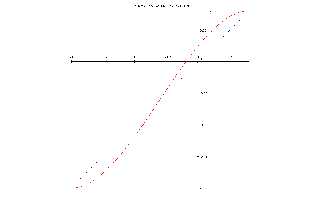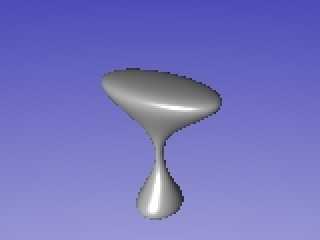|
 |
I just had another idea:
If you take a new function for your y-coordinate (which
varies linearly with u at the moment) you can have a smooth
tip. Imagine that you wander along your y-axis as u increases
from -1 to 0.4 eventually. If you start slowly, get more pace
in the middle and slow down near the end you get a smooth tip.
(I made a graph to show the y-function dependent on u).
The cubic u^2*(3-2*u) is ideal for this purpose because it
has zero-slope at u=0 and u=1. The only problem is that our
u varies from [-1, 0.4] instead of [0, 1], so we have to make
a small transformation to get our u in the range [0, 1]. We
just substitute u with (u+1)/1.4 and get the u-range right.
The last step is the scaling in y-direction, because
u^2*(3-2*u) returns values in the range [0, 1]. In summary:
u^2*(3-2*u) // set (u+1)/1.4 for u
-> ((u+1)/1.4)^2*(3-(u+1)/1.4) // *1.4 // -1
-> 1.4*((u+1)/1.4)^2*(3-(u+1)/1.4)-1
The Source looks like this:
// Almost a lathe
#version 3.5;
camera { location <3, 3, -5> look_at <0, 0, 0> angle 25}
sky_sphere { pigment {
function{abs(y)}
color_map { [0.0 color blue 0.6] [1.0 color rgb 1] }
}
}
light_source {<100,200,-500> colour rgb 1}
// The open 1D spline (lathe)
#declare S = function {
spline {
natural_spline
-1.0, < 0.0, 0, 0.0>,
-0.8, < 0.4, 0, 0.5>,
-0.5, < 0.2, 0, 0.2>,
-0.2, < 0.2, 0, 0.2>,
0.3, < 0.8, 0, 0.4>,
0.4, < 0.0, 0, 0.0>,
}
}
#declare Fx = function(x,y) {(S(u).x * sin(v)/2)}
#declare Fy = function(x,y)
{1.4*(5/7*(u+1))*(5/7*(u+1))*(3-2*(5/7*(u+1)))-1}
#declare Fz = function(x,y) {(S(u).z * cos(v)/2)}
#declare Umin = -1;
#declare Umax = 0.4;
#declare Vmin = -pi;
#declare Vmax = 1.001*pi;
parametric {
function {Fx(u,v)}
function {Fy(u,v)}
function {Fz(u,v)}
<Umin,Vmin>,<Umax,Vmax>
contained_by{box{-1,1}}
precompute 18, x,y,z
pigment {rgb 0.9}
finish {phong 0.5 phong_size 10 ambient 0.2}
}
Post a reply to this message
Attachments:
Download 'u-coordinate.png' (8 KB)
Download 'almost_lathe.JPG' (7 KB)
Preview of image 'u-coordinate.png'

Preview of image 'almost_lathe.JPG'

|
 |




![]()